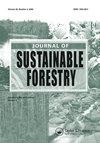Using Shrubs as Nurse-plants to Reduce Browsing and Rubbing Damage by Roe Deer: An Experimental Approach
IF 1.8
4区 农林科学
Q3 FORESTRY
引用次数: 0
Abstract
ABSTRACT We conducted a field experiment to evaluate the effectiveness of neighboring vegetation to protect cherry-wood (Prunus avium) saplings against roe deer browsing and rubbing, and determine whether this protection varies according to the attractiveness of – and the physical barrier provided by – a variety of nurse shrubs. Our results show that nurse shrubs may delay roe deer browsing and rubbing on highly attractive cherry-wood saplings, even in a situation of high deer density. The most obstructing shrubs at roe deer knee to shoulder height (Populus x canescens and Cytisus scoparius) appeared to be efficient barriers, whereas the spiny shrub (Elaeagnus angustifolia) did not protect saplings more efficiently than thornless species. Yet, obstruction appeared to be less effective against browsing when the nurse species was itself browsed (Cornus sanguinea and Alnus cordata). Since roe deer may help to reduce plantation cleaning through the control of the shrub layer, especially brambles, we argue that natural methods of protection using surrounding vegetation should represent an economic and sustainable alternative to artificial protection of saplings.利用灌木作为护理植物减少狍啃食和摩擦伤害的实验研究
摘要/ ABSTRACT摘要:本研究通过田间试验,评价了周边植被对樱桃木(Prunus avium)树苗保护的有效性,并确定了这种保护是否会根据不同护理灌木的吸引力和提供的物理屏障而变化。我们的研究结果表明,即使在鹿密度很高的情况下,护理灌木也会延迟狍对高度吸引的樱桃木树苗的浏览和摩擦。在鹿膝至肩高的灌木中,最具阻隔性的是白杨(Populus x canescens)和石竹(Cytisus scoparius),而带刺灌木(Elaeagnus angustifolia)对树苗的保护效果不如无刺灌木。然而,当看护物种(Cornus sanguinea和Alnus cordata)本身被浏览时,阻碍似乎对浏览效果较差。由于狍可以通过控制灌木层,特别是荆棘层来帮助减少人工林的清洁,我们认为利用周围植被的自然保护方法应该是人工保护树苗的经济和可持续的替代方法。
本文章由计算机程序翻译,如有差异,请以英文原文为准。
求助全文
约1分钟内获得全文
求助全文
来源期刊

Journal of Sustainable Forestry
Social Sciences-Geography, Planning and Development
CiteScore
3.90
自引率
12.50%
发文量
42
期刊介绍:
Journal of Sustainable Forestry publishes peer-reviewed, original research on forest science. While the emphasis is on sustainable use of forest products and services, the journal covers a wide range of topics from the underlying biology and ecology of forests to the social, economic and policy aspects of forestry. Short communications and review papers that provide a clear theoretical, conceptual or methodological contribution to the existing literature are also included in the journal.
Common topics covered in the Journal of Sustainable Forestry include:
• Ecology, management, recreation, restoration and silvicultural systems of all forest types, including urban forests
• All aspects of forest biology, including ecophysiology, entomology, pathology, genetics, tree breeding, and biotechnology
• Wood properties, forest biomass, bioenergy, and carbon sequestration
• Simulation modeling, inventory, quantitative methods, and remote sensing
• Environmental pollution, fire and climate change impacts, and adaptation and mitigation in forests
• Forest engineering, economics, human dimensions, natural resource policy, and planning
Journal of Sustainable Forestry provides an international forum for dialogue between research scientists, forest managers, economists and policy and decision makers who share the common vision of the sustainable use of natural resources.
 求助内容:
求助内容: 应助结果提醒方式:
应助结果提醒方式:


